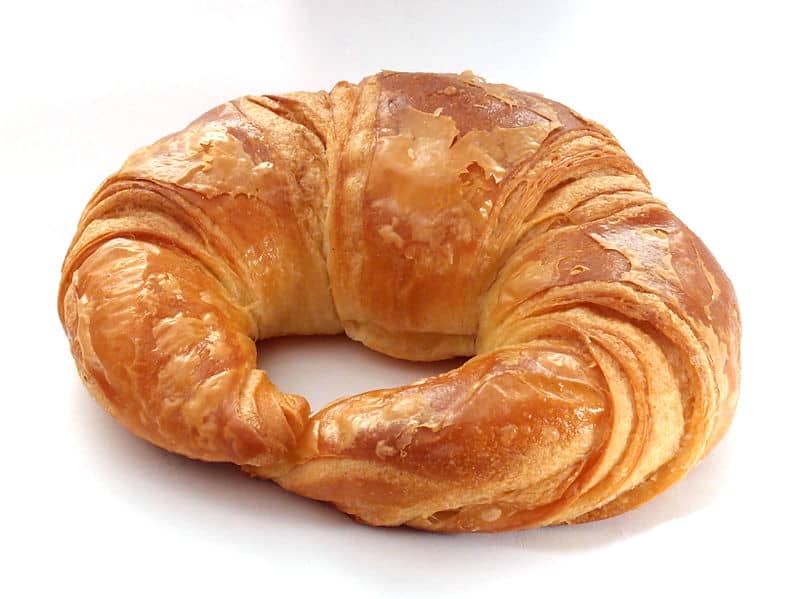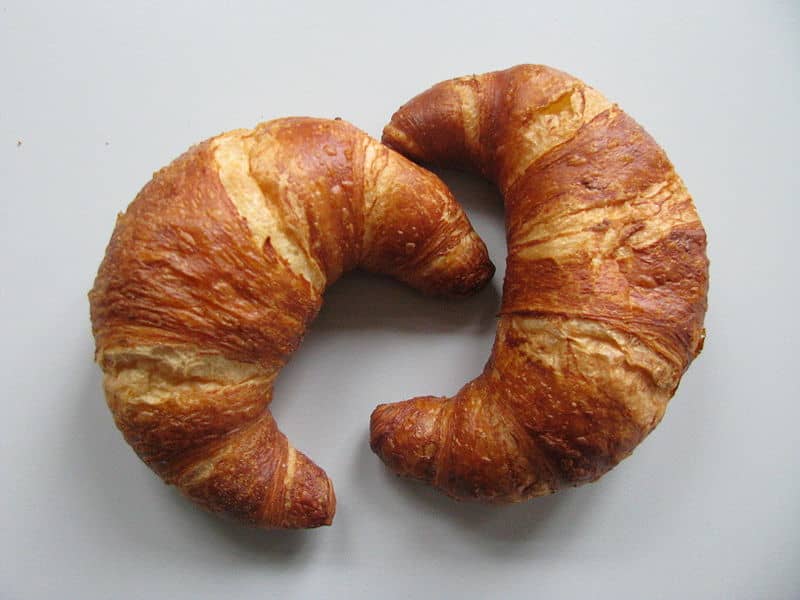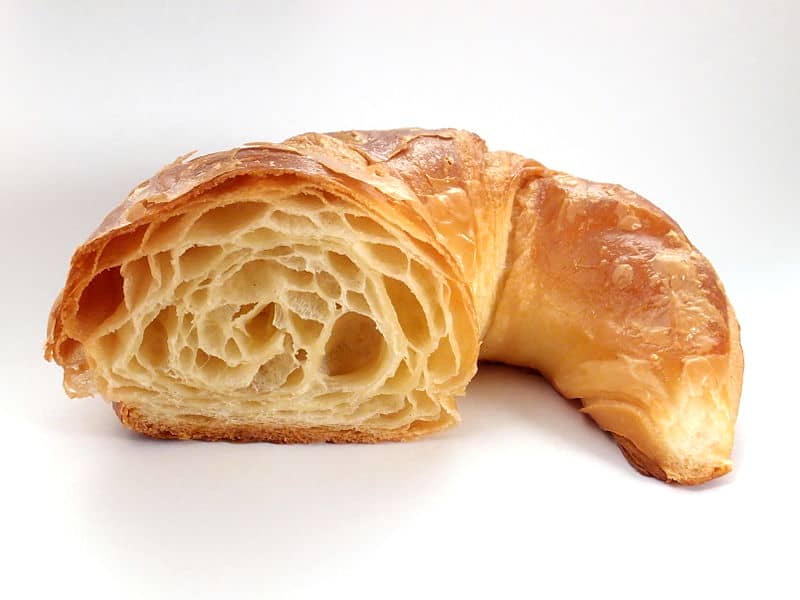Croissants are popular traditional breakfast in France made of a layered yeast-leavened dough through laminating technique.
Perhaps next to baguette, the buttery and flaky croissant is the bread mostly associated with France. But do you know that just like the famous baguettes, croissants are not actually French?
Croissants are viennoiseries. As “viennoiseries” translates as “things of Vienna,” croissants are, therefore, of Austrian origin.
Things you'll find in this article
Croissants In France: History And Recipe

History of Croissant
Crescent-shaped breads have existed since the Renaissance, the cakes even older – possibly since antiquity. Croissants have long been made and sold in Austrian, Italian, and French bakeries and pâtisseries, but the croissant that we know now was only developed in the early 1990s.
Croissant originated from kipfel, a Central European yeast bread roll that can be traced back to at least the 13th century in Austria.
Croissant was adapted from the plain kipfel sometime in 1838 or 1839 by August Zang, the very same Austrian entrepreneur who invented the famous baguette.
Zang’s popular bakery in Paris inspired French imitators, resulting in the concept of viennoiserie or Vienna-style pastries in the 20th century.
This French version of the kipfel became known for its crescent shape (French: croissant) not only in France but across the world as well.
In the early 1970s, croissant’s popularity were at such height that the pastry was adapted into different versions of sandwiches. Their fillings range from the traditional sweets like praline and almond paste to ham, tomatoes, and my personal favorite – smoked cheese.
Croissant Fun Facts

• Kipfel, which croissant originated from, is also called kifli, kiflice, and kifle. It was invented during the Turkish invasion of Vienna, Austria, in 1683. The Turks failed and to celebrate the Austro-Hungarian Empire’s victory, bakers made this pastry in the shape of the crescent moon, which is the symbol of the Turkish Empire.
• There is a French popular belief that Vienna-born Marie Antoinette introduced croissants to France in 1770. Austrian August Zang made it popular in the late 1830s.
• Not all croissants are crescent in shape. The pain au chocolat or chocolatin is a cuboid-shaped croissant filled with one or two pieces of dark chocolate. It is popular in southwestern France and Quebec, Canada.
• Another “non-crescent” croissant called the pain aux raisins – also known as the “escargot croissant” – is spiral in shape, like a snail (escargot). “Pain aux raisins” actually translates as “raisin bread” and “snail.”
• The first French reference to a croissant is in Anselme Payen’s Des substances alimentaires, published in 1853.
• Croissant became France’s national product in 1920.
• The traditional croissant is served and eaten at breakfast with butter and fruit jam, praline, almond-flavored cream called frangipane, or chocolate filling.
• Frozen croissants were introduced to the United States in 1981. Fastfood chains soon created versions of croissant to offer their diners. This led to the “Americanization of the croissant,” as declared by New York Times in an article published in 1984.
• There is a National Croissant Day! Americans have been celebrating this holiday every 30th of January since 2006.
Where to find the best croissants in Paris

Since this pastry is a famous Parisian breakfast, the best croissants in France can be found in the capital.
Here are three bakeries where you can buy the best croissants in Paris.
Stohrer
51 rue Montorgueil
75002 Paris, France
Stohrer, founded in 1730 by King Louis XV’s pastry chef, Nicolas Stohrer, is the oldest pâtisserie in the French capital. It is still located in its original location on rue Montorgueil.
Now listed as a historical site, this elegant pâtisserie offers embellished sweet and savory baked goods and desserts. Their croissants are among the best you will ever find in France.
Boulangerie Utopie
20 Rue Jean-Pierre Timbaud
75011 Paris, France
A small, popular Parisian neighborhood bakery, Boulangerie Utopie (English: Utopia Bakery) offers the freshest bread and pastries – plus a few surprising twists on popular French goodies such as croissant.
Note that because Boulangerie Utopie is so popular, you will most likely have to wait in line. It helps to know what you would like beforehand so you won’t hold the line up. My best suggestion is to order La Fleur Fraise (“Strawberry Flower”), a flower-shaped milk sourdough croissant filled with strawberry jam.
Ble Sucre
7 rue Antoine Vollon
75012 Paris, France
First thing to remember: Ble Sucre’s croissants are so delicious they sell out fast!
Ble Sucre is an easy walk from Ledru-Rollin station. This small shop’s atmosphere is very relaxing, but it will also be nice to have your Parisian breakfast al fresco. Enjoy your croissant with rum baba and chocolate éclair!
Easy Homemade French Croissant Recipe

Traditional croissants are made of a layered yeast-leavened dough through a technique called laminating.
The traditional recipe is quite intimidating, so we came up with a simple and easy homemade recipe that’s practically effortless and takes less time to make.
INGREDIENTS:
400 g. flour
260 ml. milk
180-200 g. butter
4 tbsps. sugar
1/4 tsp. salt
1 tsp. active dry yeast
(For egg wash, beat 1 egg mixed with 1 teaspoon of milk.)
INSTRUCTION:
1. Dissolve 260 ml. warm milk, 4 tbsps. sugar, and 1 tsp. active dry yeast in a bowl. This will activate the dry yeast.
2. In a separate bowl, mix 1/4 tsp. salt and 400 grams of flour. Add the first mixture – the activated yeast – and blend together until the dough is evenly hydrated.
3. Let it sit and rise for 1.5 to 2 hours or until the dough doubles in size. Divide it into 12 equal pieces, then roll each piece to create a disc shape that’s not more than 18 cm. in diameter and 2 mm. in thickness.
4. Layer butter on each disc-shaped dough, then place them on a plastic film, stacking one over the other. Don’t forget to cover each dough with the plastic film before stacking. Put them on a freezer for 30 minutes before rolling them into long rectangular sheet.
5. Cut the sheet into 24 small triangles before shaping them into crescents. Put the raw croissants on a baking a tray and proof them for 2 hours until they puff a bit.
6. Dip each dough into the egg wash and bake at 400° F for 10 minutes. Reduce the temperature to to 375° F and bake for another 10 minutes.
This recipe yields 24 mouth-watering servings.
Preparation, proofing, freezing, and baking time is 5 hours and 30 minutes.

Hi, I’m Christine – a full-time traveler and career woman. Although I’m from the Philippines, my location independent career took me to over 40 countries and lived in 4 continents in the last 10 years, including France. A self-proclaimed Francophile, I love everything France.
